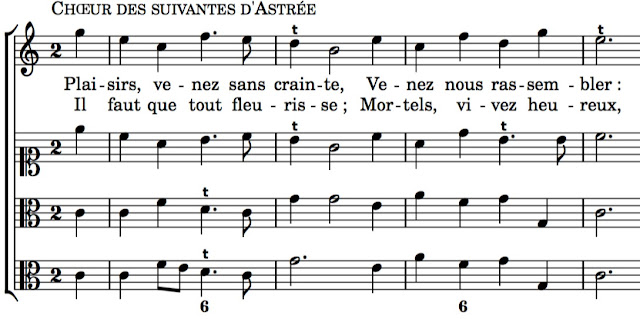For sake of comparison with the 15 menuets discussed yesterday, here are five other pieces from Antoine Pointel's Recuiel des Dances. These were chosen more or less randomly from several early pages—with somewhat awkward consequences, as we shall see.
The first has an antecedent+continuation design in the first strain, a design I frankly expected to find more often in the menuets, certainly more than 1 out of 15. In this instance the continuation phrase modulates, which is rare enough in the contredanse literature that one suspects the piece is actually "borrowed" from somewhere else. As indeed turns out to be case. Ironically, given the context of this series of posts, "Plaisir" is taken from Lully: the penultimate number in the Prologue to Phaëton (1683), the opening of which is reproduced below Pointel's score (adapted from Nicholas Sceaux's modern notation). The single pick-up note and consistent two-bar groups suggest the bourrée.
"Qu'a L'Envy" turns out to be another borrowing from Lully, this time the chorus in Acis et Galatée, Act II, scene 6 (1686). Clearly a gavotte en rondeau, Pointel's version follows the original closely, deleting only the flute flourishes that punctuate each phrase. In this instance, the first strain—the rondeau theme—is a true 4-bar theme in Lully's opera; there is no repetition, no additional text. In Pointel's version, we assume that the first strain is meant to be repeated, given the sign at the end of the first system.
"Dite Moy Ianeton" is a much simpler tune. At 4+8 it fits the (presumably) older type that has been a focus of discussion in these recent posts: an antecedent-like phrase that would generate a period if one includes its repetition. An assumption of an 8+8 design by musicians and dancers both seems very likely, given that this is obviously a gavotte—in the older notation that begins with beat 1 rather than beat 3. The gavotte was much given to very square designs, and eventually (by 1730, probably earlier) became overwhelmingly the type of the 2/4 contredanse.
Another simple tune, "L'Escossoise" is a jig in three-bar phrases, a rarety that speaks to its age by 1688. Within this constraint, the first strain is a clear antecedent-consequent period.
"L'Argentine" is another jig with a 4+4 period design in the first strain, but with an unusual move to III in the antecedent (see bar 4). The modal touches throughout suggest, again, that this tune is considerably older than its publication by Pointel in 1688.
What did we learn from this survey of random items? Perhaps mainly the fact of the randomness once we leave the confines of the named menuets. That in itself is nothing odd—anthologies from Playford on into the many in the 19th century draw on a wide variety of sources.
We can say that these five additional numbers confirm—indeed, magnify the significance of—the several, not single, options for the first strain: here we have encountered virtually all the possible options, from a true 4-bar theme to the 8-bar period that is barely more than the four bars repeated to a 6-bar period to a "true" 8-bar period with non-tonic close in the antecedent. ("True" here, of course, means the cliché of the period in the later 18th century.)





